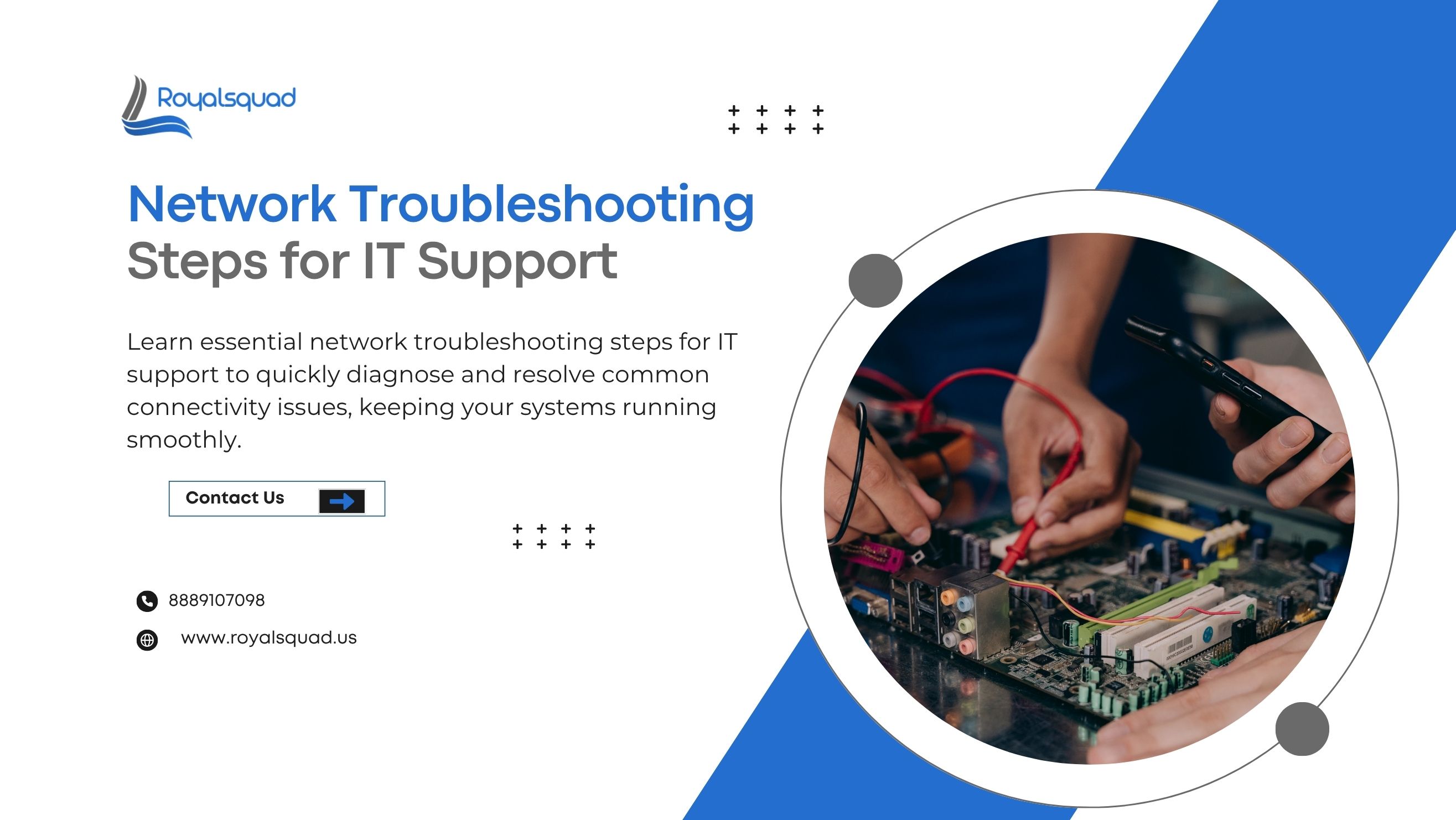
Quick and Effective Network Support Troubleshooting Steps for IT Support
The foundation of any successful company in today's interconnected world is a reliable and stable network. Productivity comes to a standstill and annoyance increases when the network fails.
Quickly identifying and fixing network problems is an essential skill for IT support workers. This blog post lists 10 simple and practical network troubleshooting procedures that can help you restore your connection quickly, reducing downtime and increasing productivity.
1. Start with the Basics: Physical Connections
Although it may seem obvious, the easiest solution is often the right one. Always inspect the physical connections before attempting complicated diagnostics
- Cables: Are all Ethernet cables securely plugged into the ports on both ends (device and switch/router)? Look for any kinks, cuts, or damage.
- Power: Is the network device (modem, router, switch, access point) powered on? Check the power adapter and ensure it's firmly connected to a working outlet. A quick power cycle (unplug for 30 seconds, then plug back in) can often resolve minor glitches.
2. Verify IP Address and Network Configuration
Incorrect IP address settings are a common culprit for network connectivity issues.
- Command Prompt (Windows): Launch the Command Prompt and enter ipconfig /all. Check that the device has a valid IP address, subnet mask, and default gateway. See if the IP address falls inside the range of what your network expects.
- IPv4 vs. IPv6: Verify that your network is configured correctly and that the right protocol is in use.
- DHCP vs. Static: Determine whether the device should acquire an IP address automatically through DHCP or whether it requires a fixed IP address. Check each parameter twice if they remain the same.
3. Ping the Gateway and Beyond
The ping command is your best friend for basic connectivity testing.
- Ping the Default Gateway: This tells you if your device can reach your local router. If this fails, the problem is likely on your local network segment or with your device's configuration.
- Ping a Known IP Address on the Same Network: If the gateway pings successfully, try pinging another device on the same local network. This helps isolate whether the issue is with your device or a broader network segment.
- Ping an External Website (e.g., Google's DNS 8.8.8.8): If local pings are successful but external ones fail, the issue might be with your router's internet connection or DNS resolution.
4. Check DNS Resolution
Even with a perfect IP configuration, if DNS isn't working, you won't be able to access websites by name.
- lookup (Windows/Linux/macOS): Use lookup google.com to see if your DNS server can resolve domain names to IP addresses.
- Change DNS Servers: Temporarily configure your device to use public DNS servers like Google (8.8.8.8, 8.8.4.4) or Cloudflare (1.1.1.1) to rule out your current DNS server as the problem.
5. Examine Network Device Status Lights
Modems, routers, and switches all have indicator lights that provide valuable clues.
The power indicator should be a constant green color.
- Internet/WAN Light: Should be flashing or steady to show that you have a live connection to your ISP.
- LAN/Ethernet Lights: For linked devices, they should be either blinking or steady.
- Wireless Lights: Show Wi-Fi activity. For the interpretation of specific light patterns, see your device's handbook's.
6. Restart Network Services and Drivers
Sometimes, a software glitch is the culprit.
- Restart Network Adapter: In Windows, go to Network Connections, disable, and then re-enable your network adapter.
- Update/Reinstall Drivers: Outdated or corrupted network drivers can cause issues. Download the latest drivers from the manufacturer's website and install them.
- Restart the Computer: The classic IT advice, but often effective. A fresh boot can resolve many underlying software conflicts.
7. Check Firewall and Antivirus Software
Security software, while essential, can sometimes inadvertently block legitimate network traffic.
- Temporarily Disable: As a diagnostic step, try temporarily disabling your firewall (Windows Firewall, third-party firewall) and antivirus software. If connectivity is restored, you'll need to configure exceptions for your applications. Remember to re-enable them immediately after testing.
- Review Logs: Check firewall logs for any blocked connections related to your issue.
8. Isolate the Problem: One Device or Many?
Determining the scope of the problem is crucial for effective network troubleshooting.
- Test Other Devices: If one device can't connect, try connecting another device (laptop, smartphone) to the same network. If other devices also have issues, the problem is likely with the network infrastructure (router, switch, ISP). If only one device is affected, the problem is likely with that specific device.
- Connect Directly: If possible, connect the problematic device directly to the modem or router to bypass other network components. This can help isolate whether the issue is with a switch, access point, or cabling.
9. Utilize Network Troubleshooting Tools (Windows)
Windows offers built-in tools that can assist with network connection troubleshoot.
- Windows Network Troubleshooter: To solve network issues, right-click the network icon in the system tray. Then, choose the option that says "Troubleshoot problems. " This will help identify and fix any network problems you are experiencing.
- nets Winsock reset: This command can repair a corrupted Winsock catalog, which can cause network connectivity problems.
- nets int Ip reset: Resets TCP/IP settings.
10. Consider External Factors and ISP Issues
- If troubleshooting doesn't work, the problem might not be yours. Check your ISP's website or social media for outages. You can also call their support. Look at your modem logs for errors or disconnections from the ISP. any errors or disconnections from the ISP's network.
By systematically working through these 10 quick and effective network troubleshooting steps, IT support specialists possess the skills necessary to recognize and resolve a range of network issues.
Keeping your company connected and reducing downtime requires a methodical approach to network troubleshooting for Windows environments and other operating systems. Regular maintenance and proactive monitoring can also prevent many network problems from occurring in the first place, ensuring a robust and reliable network infrastructure.





_1728455153.png)